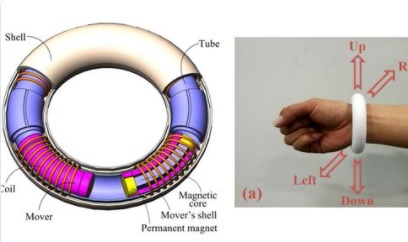
The researchers, Zhiyi Wu and coauthors at Chongqing University of Technology and the China Academy of Engineering Physics in Sichuan, have published a paper on the energy-harvesting bracelet in a recent issue of Applied Physics Letters.
"The energy-harvesting bracelet could potentially be used to help power activity trackers, smartwatches, and even some health-monitoring applications," Wu told Phys.org.
The bracelet works due to electromagnetic induction, in which the interaction between a moving magnetic field and an electrical conductor generates a voltage. Inside the bracelet's outer shell, electrically conductive
copper coils wind around an inner shell. Inside this inner shell are two moving magnets that rotate around the bracelet in response to the wearer's
wrist movements. As the magnets move through the copper coils, they generate a voltage due to
electromagnetic induction.
The researchers explain that, according to Faraday's Law, the amount of voltage generated is proportional to the number of times the magnets rotate around the bracelet. So the faster the motion, the greater the power generated by the bracelet. Tests showed that the magnets can move with an average rotational velocity of between 100 and 300 revolutions per minute, depending on the type and intensity of the wrist movements. The researchers also demonstrated that, from a single shake of the wrist, the bracelet can charge a small capacitor to approximately 1 volt in a fraction of a second and generate an average power of more than 1 milliwatt.
One of the advantages of the bracelet design is its symmetry, which allows it to transform motion in any orientation into the rotational motion of the moving magnets, and also does not require the magnets to be in any particular initial position. Other types of electromagnetic energy harvesters, such as those in the shape of tubes or flat objects, have limited degrees of freedom and only work in certain orientations.
"The greatest advantage of the bracelet is that it can transform translational motion in any orientation into
rotational motion, starting from any initial position of the magnets," Wu said.
In the future, the researchers plan to investigate several different areas. One idea is to use a circular magnetization magnet to fabricate the magnets. They also want to further reduce friction in the
bracelet and introduce triboelectric energy-harvesting technology to utilize the remaining friction.

